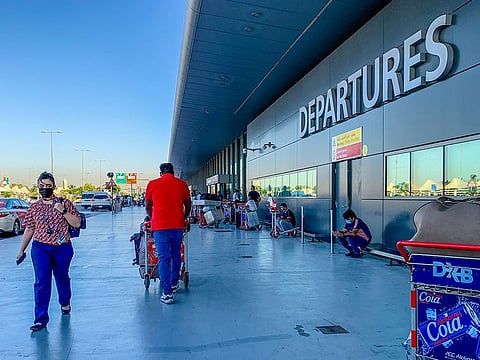Gulf’s airports can still do well as hubs in a post-COVID-19 world
But they will still have to make some strategic readjustments

Although traffic across all routes operated by Gulf carriers drastically decreased during the pandemic, the volume of connecting traffic was among the hardest hit due to its increasing complexity. Questions have arisen as to whether the crisis will lead to structural changes within the airline industry and when connecting traffic will return to pre-crisis levels.
After every single crisis in the past, the landscape of aviation has changed fundamentally, and this will likely be the case after COVID-19. I believe the hub-and-spoke model will remain relevant, but to make that happen, Gulf carriers will need to reshape their strategies around operations and network.
In recent years, the demand for connecting flights between key markets has been rising – because of many financial and logistical advantages for airlines, airports and passengers. In addition, the constant improving of customer experience at hub airports has also contributed to demand for one-stop itineraries. Thus, the hub model has been a cornerstone of Gulf carriers like Emirates and Etihad Airways - and it will continue to be.
However, Gulf carriers will have to rethink and redesign the model. The rebuilding of hub systems is considerably more complex than point-to-point networks – due to the regional differences in COVID-19 restrictions and the inter-dependencies among routes.
Challenges getting complex
Before the pandemic, the future of the hub model was questioned by experts, triggered by the changing aircraft technology favoring direct flights (point-to-point, long-haul thin routes and ultra long-haul flights), change in customer preferences (avoiding stress around tight connections), environmental concerns threatening circuitous itineraries, and finally, congestions at various mega-hubs, including Heathrow.
These were potential limitations to the further growth of hub airports and hub carriers. The pandemic can be considered as another major threat in the short- and medium-term.
Still have relevance
The pandemic will put short-term pressure on hubs in the Gulf, and in the longer term, there will be fewer left on the aviation map worldwide. But we can agree that the hub model in the Gulf will remain relevant in a post COVID-19 era, especially in the UAE. Long-term trends in aviation, rising demand for ‘thinner’ routes, and the increasing market share and importance of leisure and VFR travel (visiting friends and relatives) during and after the pandemic will support the hubs in the Gulf.
The VFR segment will come back first, followed by leisure/tourism travel. Business travel will take a longer time to return to pre-COVID-19 levels. Due to having large marketshare in the VFR and leisure segments, Gulf carriers could be in a good pole position to use the current crisis and the recovery patterns to their advantage.
In general, price-sensitive leisure and VFR travel is more closely linked with connecting flights via hubs.
Get tactical
In the short term, Gulf carriers will need to rebuild their networks in a tactical way by reducing dependency on connecting traffic (reopening of networks). In collaboration with the stakeholders, they need to work on joint strategies how to lure more leisure and business demand to their cities.
In the longer term, the Gulf carriers have to reappraise their market positioning, revenue management and pricing strategies, fleet structure (aircraft technology), and, most importantly, in better use of data.
Make data an ally
In saying this, the Gulf carriers have to become more customer-centric. They have to put their customer first and at the core of their business to build long-term relationships. With the help of their loyalty programmes as an all-encompassing platform (access to large amount of data about customers), Gulf carriers can grow lasting customer relationships.
The true driver behind a successful modern loyalty programme is Big Data – the detailed information it captures on consumers through an array of interactions across all channels. Through better use of data and constant highlighting the safety and health benefits, Gulf carriers would be able to reduce the churn rate of connecting passengers in the short- and long-term.
Privileges
The reassessment of the level of ‘network privilege’ should also factor heavily into the design of the Gulf’s mega-hubs like Dubai for the longer term. Especially because the key source of the Gulf carrier’s value creation is network privilege, which is the carrier’s ability to offer every single customer segment a unique service.
Concentrating passengers through the Gulf hubs enable the likes of Emirates to offer connections for markets that lack sufficient demand for a non-stop link – thereby creating a cycle of reward between the carrier and passengers. Therefore, it is necessary for Gulf carriers to reassess the level of privilege in their networks (e.g. reorientation of services by launching flights to secondary cities with smaller aircraft).
The current crisis in the aviation industry does not spell the end for the hub model in the Gulf. The development of efficient aircraft like the Boeing 787 may empower hubs rather than threaten their importance. Because the economic benefits remain largely intact for the Gulf hubs and carriers (efficient model) and its passengers (attractive fares).
It is essential for hub carriers to make the most of this opportunity to reevaluate their network and fleet strategies. Although there will be fewer hubs across the globe in the future, the remaining hubs (e.g. Dubai) will emerge stronger and become more profitable if they make the necessary short-, medium- and long-term adjustments to their current and future model.
Ultimately, the growing VFR segment - driven by the globalization effect - will play a crucial part in keeping the hubs alive.

- Linus Benjamin Bauer is Managing Director at Bauer Aviation Advisory and visiting lecturer at City University of London.
Sign up for the Daily Briefing
Get the latest news and updates straight to your inbox







